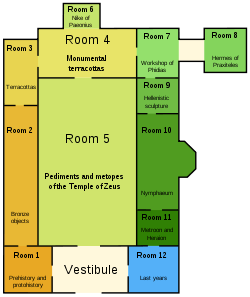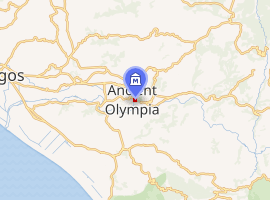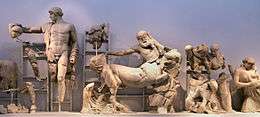Archaeological Museum of Olympia
The Archaeological Museum of Olympia (Greek: Αρχαιολογικό Μουσείο Ολυμπίας) is one of the principal museums of Greece, located in Olympia. It is overseen by the Ministry of Culture and Sports, and, as of 2009, is directed by Georgia Xatzi. When the original building was completed and opened in 1882, it was the first museum in Greece outside of Athens.
 | |

| |
| Established | 1982 (New museum) |
|---|---|
| Location | Ancient Olympia, Elis, Greece |
| Type | Archaeological museum |
The museum houses discoveries from the surrounding area, including the site of the Ancient Olympic Games. The collection includes objects produced and used in the area from prehistory to its time under Roman rule. The principal pieces in the museum are Hermes and the Infant Dionysus (attributed to Praxiteles), some objects from the Temple of Zeus, the Nike of Paionios, as well as an oenochoe that belonged to Phidias. The extent of its bronze collection makes it one of the most important in the world.
Today, the museum is housed in two buildings: the principal building with twelve rooms for exhibitions, organized both around themes and ages of the objects. The other building is dedicated to the museum store, and is separate from the main structure, located on the path to the archaeological site.
History of the museum
Excavation work at Altis in the 19th century quickly necessitated the construction of a building to display uncovered objects and works of art. The banker Andreas Syngros paid 220,000 drachmas to fund the construction and entrusted the design and building of the museum to two German architects and archaeologists who had begun the excavation on the site. Wilhelm Dorpfeld and Friedrich Adler, the architects, oversaw the construction of a neo-classical building which was erected on the hill of Drouva near the way out of Olympie toward the sanctuary. Finished in 1888, it was the first Greek museum built outside of Athens. It was damaged in 1954 by an earthquake, and later proved ultimately too small to house and display the museum’s expanding collections. Plans to build a new museum were approved in the 1970s. Although it was unused for some time, the original building was re-purposed and since 2004 has been a museum about the history of the original Olympic games.
Collections

- Collection of terracottas (prehistoric, Archaic and Classical periods).
- Collection of bronzes.
- Collection of sculptures (Archaic up to the Roman periods).
- Collection from the Olympic Games.
Notable holdings and exhibits
- The Hermes and the Infant Dionysus by Praxiteles (possibly)
- The Nike of Paionios
- Zeus carrying Ganymedes
- Pediments of the Temple of Zeus
- The helmet of Miltiades
- Miniature bronze statue of a horse
The statue of Apollo from the west pediment of the Temple of Zeus was depicted on the obverse of the Greek 1000 drachmas banknote of 1987-2001.[1]
Gallery
See also
References
- Bank of Greece Archived March 28, 2009, at the Wayback Machine. Drachma Banknotes & Coins: 1000 drachmas Archived October 5, 2007, at the Wayback Machine. – Retrieved on 27 March 2009.
External links
| Wikimedia Commons has media related to Archaeological Museum of Olympia. |
